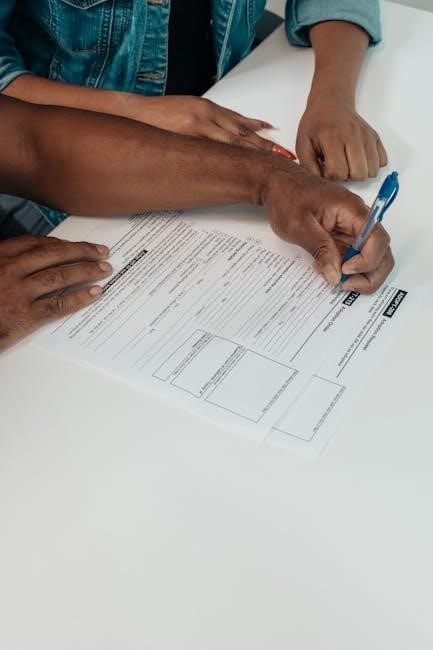A scholarship application letter is a formal document requesting financial aid, showcasing qualifications, goals, and passion for education. It serves as a critical introduction to the applicant.
1.1 Understanding the Purpose
A scholarship application letter serves as an introduction to the scholarship committee, presenting your background, achievements, and goals. Its primary purpose is to convey your interest in the scholarship and demonstrate how it aligns with your academic and career aspirations. This letter is your opportunity to showcase your qualifications, express your financial need, and highlight what makes you a standout candidate. It helps the committee understand your potential and how the scholarship will support your educational journey.
By clearly articulating your objectives and passion, you establish a personal connection with the reviewers, making your application memorable. This letter is not just a request for funding but a chance to tell your story and illustrate how the scholarship will empower you to achieve your goals.
1.2 Importance in the Scholarship Process
The scholarship application letter is a critical component in the selection process, as it provides a personalized glimpse into your background, motivations, and aspirations. It allows the committee to assess your fit for the scholarship beyond academic records. A compelling letter can differentiate you from other applicants, showcasing your unique qualities and alignment with the scholarship’s objectives. This document often serves as the first impression, making its quality and sincerity vital for securing funding opportunities.
Structure of a Scholarship Application Letter
A scholarship application letter typically follows a standard format, including a header, greeting, introduction, body paragraphs, and conclusion. It should be clear, concise, and professional.
2.1 Standard Format and Components
A scholarship application letter should include a header with contact information, a formal greeting, and a clear introduction stating the purpose. The body should highlight academic achievements, financial need, and career goals. It should also express gratitude and conclude with a polite closing. Proper formatting ensures professionalism and readability, making the letter stand out to the selection committee. Personalization and clarity are key to making a compelling case for the scholarship.
The introduction should grab attention by formally addressing the committee and stating the purpose of the letter. The body details academic achievements, financial need, and career goals, showcasing qualifications. The conclusion summarizes suitability for the scholarship and expresses gratitude. Each section must be concise, ensuring clarity and focus. Proper transitions between sections maintain flow, making the letter cohesive and impactful. This structure helps the committee quickly assess the applicant’s eligibility and enthusiasm.

Purpose and Function of the Letter
The scholarship application letter serves as a formal request for funding, showcasing the applicant’s qualifications, financial need, and goals, while demonstrating their suitability for the award.
3.1 Expressing Interest and Qualifications
The scholarship application letter introduces the applicant, highlighting their academic achievements, skills, and experiences. It expresses genuine interest in the scholarship and explains why they are a strong candidate. By detailing qualifications, such as GPA, awards, or community involvement, the letter demonstrates alignment with the scholarship’s purpose. Additionally, it outlines how the funding will support their education and future goals, showcasing their potential to make a meaningful impact. Clarity and sincerity are essential to leave a lasting impression.
3.2 Highlighting Financial Need and Goals
In the scholarship letter, clearly articulate your financial situation and how the award will alleviate burdens. Specify tuition costs, living expenses, or other educational fees. Link the scholarship to your ability to pursue your degree without financial stress. Additionally, outline your short- and long-term goals, such as academic pursuits, career aspirations, or community contributions. Demonstrate how the scholarship will enable you to achieve these objectives, showcasing your commitment to making a meaningful impact with the support provided.

Types of Scholarship Letters
Scholarship letters are categorized based on their purpose, such as academic excellence, financial need, community service, or leadership roles, each tailored to highlight specific qualifications.
4.1 Letters for Academic Excellence
Letters for academic excellence focus on showcasing a student’s intellectual achievements, such as high GPAs, academic awards, or notable research. They highlight specific academic accomplishments, demonstrating how the applicant excels in their field. These letters often include details about relevant coursework, academic projects, or competitions that underscore the student’s dedication and aptitude. The tone is professional and enthusiastic, emphasizing the applicant’s potential to contribute meaningfully to their chosen discipline with the support of the scholarship.
4.2 Letters for Financial Need
Letters for financial need emphasize the applicant’s economic challenges and how the scholarship would alleviate these burdens. They provide a clear explanation of financial circumstances, such as family income, expenses, or unexpected hardships. These letters also highlight the applicant’s commitment to education and how the scholarship would enable them to focus on their studies without financial strain. The tone is sincere and demonstrates a genuine need for support to achieve academic goals.
4.3 Letters for Community Service
Letters for community service highlight the applicant’s dedication to volunteering and helping others. They detail specific activities, such as mentoring, charity work, or environmental projects, showcasing empathy and a commitment to societal improvement. These letters emphasize how community service has shaped the applicant’s values and future goals. By illustrating a passion for giving back, these letters demonstrate the applicant’s character and potential to make a positive impact beyond academia.
4.4 Letters for Leadership Roles
Letters for leadership roles emphasize the applicant’s experience in guiding teams or projects, showcasing their ability to inspire and manage effectively. These letters highlight specific leadership achievements, such as organizing successful events or mentoring peers. By demonstrating initiative and responsibility, the applicant illustrates their potential to lead and contribute positively in their future endeavors. This focus on leadership underscores the applicant’s readiness to make a meaningful impact, aligning with the scholarship’s goals of fostering capable and visionary individuals.

How to Write a Scholarship Application Letter
Start with a clear introduction, state your purpose, and outline your qualifications. Include key sections like introduction, body, and conclusion. Keep it concise, professional, and tailored to the scholarship. Proofread thoroughly to ensure error-free writing and a polished tone that reflects your genuine interest and commitment to your goals;
5.1 General Writing Guide
When crafting a scholarship application letter, maintain a professional and respectful tone. Clearly express your interest and qualifications, aligning them with the scholarship’s purpose. Use personal anecdotes to convey passion and commitment, making your letter memorable. Ensure clarity and conciseness to engage readers effectively. Tailor your content to reflect the scholarship’s specific criteria, demonstrating a genuine understanding of its goals. Proofread diligently to eliminate errors, ensuring a polished and professional presentation.
5.2 Step-by-Step Writing Process
Begin by brainstorming ideas and outlining key points. Start with a polite introduction, stating your purpose and expressing gratitude for the opportunity. In the body, highlight your academic achievements, relevant experiences, and future goals. Conclude by thanking the committee and reiterating your enthusiasm. Proofread for clarity, grammar, and conciseness. Ensure the tone remains professional yet personal, showcasing your unique qualities and alignment with the scholarship’s mission.

Content and Tone Considerations
Content and tone considerations are crucial for a compelling scholarship application letter. Maintain professionalism, respect, and formality while showcasing genuine passion. Be clear, concise, and authentic in your writing.
6.1 Professionalism and Respect
A scholarship application letter must maintain a professional and respectful tone throughout. Avoid slang, jargon, or overly casual language. Use formal greetings such as “Dear Members of the Scholarship Committee” or “Dear [Specific Name].” Show respect by acknowledging the committee’s time and effort. Be polite and courteous in expressing your gratitude for the opportunity. Ensure your language reflects maturity and sincerity, demonstrating that you value the scholarship and the organization offering it.
6.2 Personal Stories and Passion
Incorporating personal stories and passion into your scholarship application letter creates a meaningful connection with the reader. Share specific experiences or challenges that shaped your academic or career aspirations. Highlight moments that ignited your passion for your field of study or community involvement. Connecting these narratives to your goals demonstrates how the scholarship will empower you to achieve them. Authenticity and sincerity make your application stand out, showing the reviewer your genuine commitment to your future.
6.3 Clarity and Conciseness
Clarity and conciseness are essential in a scholarship application letter to ensure your message is easily understood. Avoid overly complex language or unnecessary details. Use simple, direct sentences to convey your points effectively. This approach helps the scholarship committee quickly grasp your qualifications, goals, and financial need. Edit your letter to remove any redundant information and ensure every word adds value. A clear and concise letter leaves a strong, professional impression.

Tips for an Effective Letter
To craft a compelling scholarship application letter, focus on clarity, sincerity, and relevance. Use specific examples to demonstrate your achievements and alignment with the scholarship’s mission. Stay concise, ensuring each paragraph transitions smoothly to maintain the reader’s interest. Personalize your letter to reflect your unique story and aspirations, avoiding generic statements. Finally, proofread meticulously to eliminate any errors and ensure professionalism.
- Begin with a strong, personal story to captivate the reader.
- Express genuine passion for your field of study or cause.
- Clearly articulate your goals and how the scholarship will aid them.
7.1 Making a Strong First Impression
A compelling opening statement is essential to grab the reader’s attention. Begin with a polite greeting and clearly state the purpose of your letter. Show enthusiasm for the scholarship opportunity and align your goals with the organization’s values. A strong first paragraph sets the tone for the rest of the letter, demonstrating professionalism and sincerity. Ensure your introduction is concise, well-written, and highlights your unique qualifications to make a lasting impression.
7.2 Demonstrating Passion and Commitment
When writing a scholarship application letter, it is crucial to showcase your passion and commitment to your field of study or chosen career. Highlight specific experiences, such as projects or volunteer work, that reflect your dedication. Share personal stories that illustrate your drive and enthusiasm. Connecting your goals to the scholarship’s purpose can also demonstrate alignment with the organization’s values. Be sincere and provide concrete examples to make your letter memorable.
7.3 Showcasing Achievements and Goals
When writing a scholarship application letter, it is essential to highlight your achievements and align them with your future goals. Clearly outline your academic accomplishments, extracurricular activities, and any awards or recognitions. Demonstrate how these achievements prepare you to achieve your goals, such as pursuing higher education or contributing to your community. Connect your aspirations to the scholarship’s purpose, showing how the funding will help you succeed. Be specific, passionate, and forward-looking to create a compelling narrative.

Common Mistakes to Avoid
Common mistakes include overemphasizing financial need, lack of personalization, and poor grammar. Avoid generic content and ensure each letter is tailored. Proofread thoroughly to avoid errors.
8.1 Overemphasis on Financial Need
While financial need is a critical aspect of scholarship applications, overly focusing on it can detract from showcasing your strengths and achievements. Avoid making your letter solely about money; instead, balance it with your academic goals, skills, and aspirations. Highlighting only financial struggles may lead to a negative impression, making it seem like you lack motivation or vision. Always connect your financial situation to how the scholarship will help you achieve your educational and career objectives. This approach demonstrates responsibility and ambition, creating a more holistic appeal.
8.2 Lack of Personalization
A common mistake in scholarship application letters is the lack of personalization, which can make the letter seem generic and impersonal. Failing to tailor the content to the specific scholarship or institution shows a lack of effort and understanding. To avoid this, research the scholarship provider and highlight how your goals, experiences, and values align with their mission. Addressing the committee by name and referencing specific program details demonstrates genuine interest and sincerity, making your application stand out.
8.3 Poor Grammar and Spelling
Poor grammar and spelling in a scholarship application letter can significantly harm your chances of securing funding. These errors create a negative impression, suggesting carelessness or lack of attention to detail. Scholarship committees often view such mistakes as a reflection of the applicant’s seriousness and professionalism. Always proofread your letter multiple times and consider using grammar-checking tools or seeking feedback from others to ensure error-free writing.

Sample Letters and Templates
Access sample scholarship application letters in PDF format from official websites, educational institutions, or scholarship platforms. These templates provide structure and content guidance, ensuring a professional presentation. They often include sections for personal details, academic achievements, and financial need statements, helping applicants craft compelling requests effectively.
9.1 Accessing PDF Samples Online
Accessing PDF samples of scholarship application letters is straightforward. Many websites offer free downloadable templates, such as official university portals, scholarship platforms, and educational blogs. These samples provide a clear structure, including headings, paragraphs, and formatting. They are ideal for understanding how to present qualifications, goals, and financial needs effectively; Users can tailor these templates to suit their specific requirements, ensuring a professional and personalized application. Always verify the source for reliability and relevance to the scholarship type.
9.2 Using Templates Effectively
Using scholarship application letter templates can streamline your writing process. They provide a structured format, ensuring you cover all essential sections like introduction, body, and conclusion. However, avoid generic content—personalize the template with your achievements, goals, and experiences. Customize fonts, colors, and layouts to match your style while maintaining professionalism. Ensure the final document is error-free and tailored to the specific scholarship requirements. This approach saves time and helps create a polished, impactful letter.

Formatting for PDF
Formatting your scholarship application letter as a PDF ensures professional presentation. Use standard fonts like Arial or Times New Roman in 12pt size for readability.
10.1 Professional Layout and Design
A professional layout is crucial for a scholarship application letter PDF. Use standard margins (1 inch on all sides) and a clean font like Arial or Times New Roman in size 12. Ensure proper spacing between paragraphs and sections. Include a header with your contact information and date. Avoid overly decorative designs; keep it simple and elegant. Use bullet points sparingly for clarity. Ensure consistency in formatting throughout the document. A well-designed layout enhances readability and professionalism.
10.2 Ensuring Readability
To ensure readability in your scholarship application letter PDF, use a standard font like Arial, Times New Roman, or Calibri in size 10-12 points. Maintain proper line spacing, such as 1.5 or double spacing, and adequate margins (at least 1 inch on all sides). Avoid overly complex layouts and ensure high contrast between text and background for easy reading. A clean, professional format enhances the reviewer’s ability to focus on your content.

Submission and Follow-Up
Submission requires careful attention to deadlines and formatting. Ensure your application letter is proofread and submitted on time. Use online portals or mail as specified.
After submission, confirm receipt and wait. Follow up politely if necessary, maintaining professionalism. Keep a copy for your records and future reference.
11.1 Meeting Deadlines
Meeting deadlines is crucial when submitting a scholarship application letter. Missing a deadline can result in an automatic disqualification, regardless of the applicant’s qualifications. It is essential to carefully review and note the submission date, ensuring all materials are prepared and reviewed well in advance. Creating a schedule and setting reminders can help applicants stay organized and avoid last-minute rush. Submitting the application early demonstrates responsibility and professionalism, increasing the chances of a positive impression.
11.2 Post-Submission Etiquette
After submitting your scholarship application letter, maintain professionalism by sending a polite thank-you note to the committee. This demonstrates appreciation for their time and consideration. Avoid frequent follow-ups, as it may appear impatient. If necessary, wait at least two weeks before sending a brief, courteous inquiry. Ensure all communication is respectful and concise. Remember, patience and professionalism are key during this phase.
A well-crafted scholarship application letter is vital for showcasing your qualifications and passion. Use these insights to create a compelling request and boost your chances of securing funding for your academic pursuits.
12.1 Summary of Key Points
A scholarship application letter is a critical document that highlights your qualifications, financial need, and future goals. It requires a professional tone, clear structure, and personalized content. Including personal stories and achievements can make your letter stand out, while avoiding errors ensures professionalism. Using templates and proper formatting, especially for PDF submissions, is essential. By following these guidelines, you can create a compelling letter that increases your chances of securing a scholarship.
12.2 Final Thoughts and Encouragement
Writing a scholarship application letter is a significant step toward achieving your educational goals. Remember, your letter is a reflection of your dedication and potential. Always maintain professionalism, highlight your achievements, and express genuine gratitude. Tailor your letter to each scholarship, showing how it aligns with your aspirations. Don’t hesitate to showcase your passion and unique story. With persistence and a well-crafted letter, you can make a lasting impression and increase your chances of securing the support you need. Stay confident and persistent in your pursuit of opportunities.
